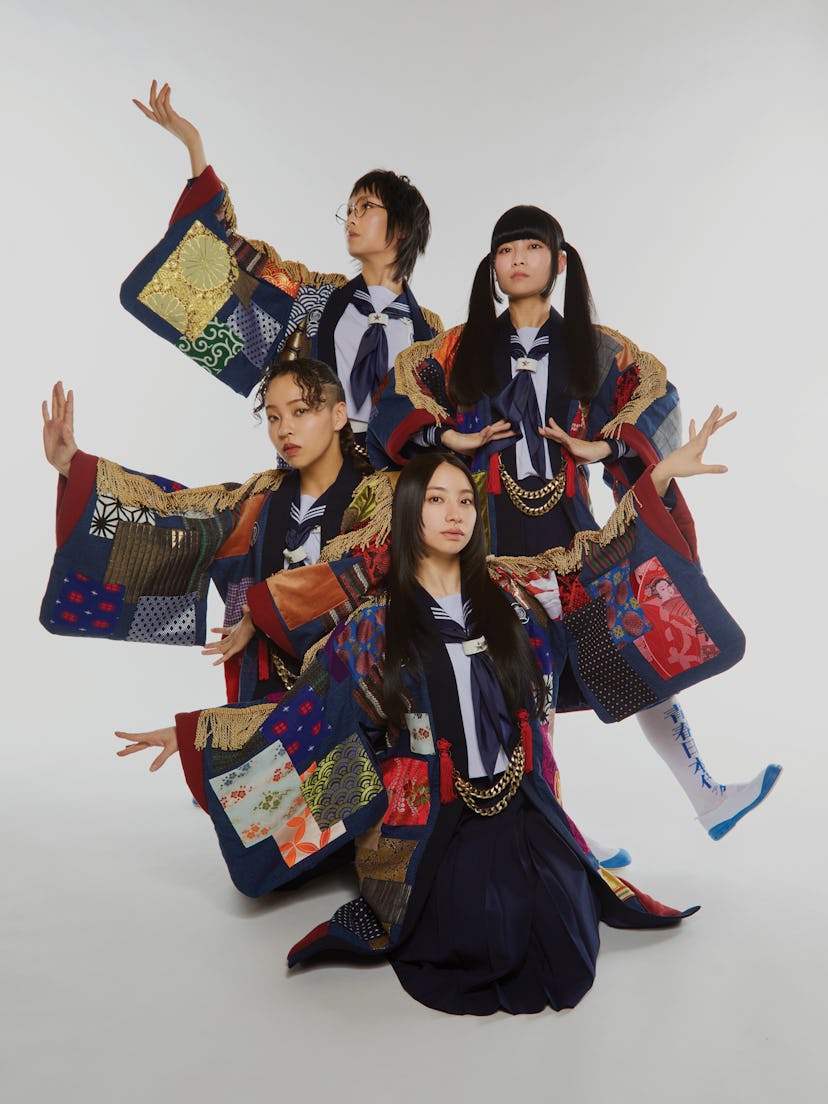
From The Magazine
Atarashii Gakko! Are Singularly, Unapologetically Themselves
The Japanese dance unit–slash–girl group call themselves the new school leaders. They’re here to free you from burnout culture.
The four young women wore military helmets and dead-serious expressions. Their fingers, sheathed in tailored white gloves, wiggled on loose wrists. Over a beat of hard-driving taiko drums, they scurried and bounced around the soundstage, scream-singing lyrics that, per the closed caption translation, described a domestic dystopia: “Dad’s stuck in the grind, the job’s grip is appalling / Mom’s escaping reality, addicted to idols.” It was the explosive U.S. television debut of Atarashii Gakko!, and if you caught it on Jimmy Kimmel Live! late last year, you might have asked yourself: Where did these women come from?
One answer is that Atarashii Gakko! formed in Japan in 2015 and are managed by talent agency Asobisystem, also responsible for Kyary Pamyu Pamyu. Some Japanese media claim they met in a supermarket aisle. In a phone interview, the women, who are in their early 20s, tell me they’ve known one another since they were schoolgirls. “The official story is we were called by the time and era,” says Suzuka, who has a rocker shag haircut and round, wire-rimmed glasses. “When the era calls for us, we will appear. The four of us come together.”
Adding to the aura of mystery is the group’s singular, unplaceable style. Unlike other J-pop idols, Atarashii Gakko!’s retro-sailor school uniforms have the boxy, knee-grazing cut of the 1980s. The sci-fi outfits they wore to perform “Tokyo Calling” on Kimmel! were inspired by a ’60s tokusatsu show, Ultraman. For their recent single, “Toryanse,” they added traditional haori robes, remixed with quilted fabrics and chain closures, over their standard uniforms.
Asked why the current moment called for Atarashii Gakko!’s formation, they are open: The mental health crisis facing Japan (and the world), where a culture of overwork, high-pressure academics, and rigid societal expectations can make teens feel despair about growing up. They want to be role models for a way through. Their name translates to “new school,” and they wear red armbands connoting a status of student council president.
“A lot of the messaging comes down to how we can follow [school or societal] rules but be free within those constraints,” says Suzuka. “And I think everyone’s going to express their own style, their own set of values that help them be themselves while also following the rules.”
That applies to them as artists, too, Suzuka says. With matching outfits, they have distinct haircuts and hope, as a group, to “multiply” the genres that individually inspire them, including jazz, funk, and hip-hop. Their whiplash-inducing choreography is aggressive, often unpretty, and totally original. Influenced by classic butoh theater and hip-hop, there is a determination not to be objectified or pigeonholed.
Rin, who has curly bangs and an undercut ponytail, says the choreography is a product of their upbringings. “We were dancing from when we were really, really small, and we all grew up in different regions in Japan.” Kanon, who wears her straight hair down, adds that the early days of TikTok were an ideal incubator for them to develop their group style. “In 2019, TikTok was still a place where really attractive people or girls would do these dances, and we thought to ourselves, ‘How do we partake in this but still have our own identity and brand?’” she says.
In 2020, Atarashii Gakko! signed with 88rising, a hybrid record label and music collective that promotes Asian artists in the United States. The company has successfully ushered in a number of East Asian acts to the Western market, including Hong Kong hip-hop star Jackson Wang, Japanese-Australian lo-fi musician Joji, and Indonesian rapper Rich Brian. “This was before we were big in Japan,” says Mizyu, who has blunt bangs and long pigtails. “Without any expectations, we listened to our gut and decided to just go to the U.S. to see what would happen.”
Success at home found them anyway in early 2023, when their funky, ’70s-inspired single “OTONABLUE,” originally released three years prior, went viral on Japanese TikTok. “Suddenly they were everywhere in Japan,” says Tokyo-based music writer Patrick St. Michel. “They showed up on TV shows, ads for coffee, assorted YouTube videos. I’ve seen my 70-year-old mother-in-law get into ‘OTONABLUE’ because it riffs on music she grew up listening to, albeit with a modern twist.”
The group has been pleasantly surprised and galvanized by the reception they’ve found playing festivals in New York and L.A. They especially loved to see fans of all ages and genders wearing sailor schoolgirl uniforms. “Seeing that from the stage makes us really, really happy,” says Mizyu.
Onstage and off, Atarashii Gakko! radiate a chaotic energy, ping-ponging off one another like kids who’ve had way too much sugar, especially when I ask about their reaction to being asked to play Coachella. The women burst out in an upbeat cacophony of sound that their interpreter can only describe as “a huge and resounding yes, for sure.”
“I watched a documentary of Beyoncé at Coachella,” adds Suzuka, laughing. “There’s a part of me that believes participating in Coachella will bring me one step closer to Beyoncé.”
Photographs by Toshio Ohno
Styling by Masato(fantastic!)
Hair and Makeup: Youca
Talent Bookings: Special Projects
Contributing Style Director: Jan-Michael Quammie
Photo Director: Alex Pollack
Editor in Chief: Lauren McCarthy
SVP Fashion: Tiffany Reid
SVP Creative: Karen Hibbert